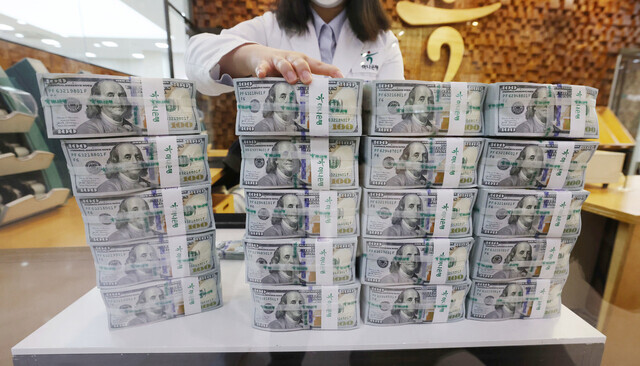hankyoreh
Links to other country sites 다른 나라 사이트 링크
S. Korea faces heightened risk of stagflation in late 2022, report warns

The South Korean economy faces an increased risk of stagflation during the second half of the year as it faces simultaneous rises in prices, interest rates, and the exchange rate, analysts are predicting.
On Sunday, the Hyundai Research Institute published a report on economic issues it expects Korea may face in the second half of 2022. In it, the authors observed, “With the Bank of Korea hinting at additional hikes in the benchmark interest rate as rising raw material prices increase the upward pressure on prices, [South Korea] is facing a triple threat with the high exchange rate [weak performance of the won] amid the US’ intensive austerity measures.”
Accordingly, they predicted a risk of stagflation — rising prices amid conditions of economic stagnation — or “slowflation,” in which prices rise amid conditions of low growth rather than economic recession.
South Korea has faced this kind of “triple high” situation twice since 2000, in the years 2001 and 2008–2009, and suffered an economic slowdown both times.
The institute predicted a strong possibility that the same combination of simultaneous pressures could cause the economic growth rate to fall during the second half of 2022. The reasons stem from the negative effects on domestic demand as high prices and interest rates translate into reduced consumption and a larger interest burden for households and companies.
While high exchange rates have a positive aspect in terms of boosting export competitiveness, they can also hurt the current account balance when rising prices of raw materials and other imports lead to increased inflation pressures and reduced trade.
China’s lockdown measures based on its “zero-COVID” policy approach are also expected to add to the upward pressures on import prices for South Korea, which is heavily reliant on trade with China.
With signs pointing to the Shanghai lockdown dragging on into the longer term, the possibility of Beijing and other major cities also going into lockdown has raised the risk of inflation stemming from supply chain shocks.
In terms of individual livelihoods, another danger is that the persistent “triple high” situation could deepen the polarization among households as it leads to rising prices for essential goods and a growing interest repayment burden.
In its report, the institute predicted that the damages would be “focused on vulnerable segments such as low earners and self-employed small business operators who face high interest repayment burdens and spend a high proportion of their earnings on essential living expenses.”
By Han Gwang-deok, finance correspondent
Please direct questions or comments to [english@hani.co.kr]

Editorial・opinion
![[Column] Season 2 of special prosecutor probe may be coming to Korea soon [Column] Season 2 of special prosecutor probe may be coming to Korea soon](https://flexible.img.hani.co.kr/flexible/normal/500/300/imgdb/original/2024/0426/3317141030699447.jpg) [Column] Season 2 of special prosecutor probe may be coming to Korea soon
[Column] Season 2 of special prosecutor probe may be coming to Korea soon![[Column] Park Geun-hye déjà vu in Yoon Suk-yeol [Column] Park Geun-hye déjà vu in Yoon Suk-yeol](https://flexible.img.hani.co.kr/flexible/normal/500/300/imgdb/original/2024/0424/651713945113788.jpg) [Column] Park Geun-hye déjà vu in Yoon Suk-yeol
[Column] Park Geun-hye déjà vu in Yoon Suk-yeol- [Editorial] New weight of N. Korea’s nuclear threats makes dialogue all the more urgent
- [Guest essay] The real reason Korea’s new right wants to dub Rhee a founding father
- [Column] ‘Choson’: Is it time we start referring to N. Korea in its own terms?
- [Editorial] Japan’s rewriting of history with Korea has gone too far
- [Column] The president’s questionable capacity for dialogue
- [Column] Are chaebol firms just pizza pies for families to divvy up as they please?
- [Column] Has Korea, too, crossed the Rubicon on China?
- [Correspondent’s column] In Japan’s alliance with US, echoes of its past alliances with UK
Most viewed articles
- 1AI is catching up with humans at a ‘shocking’ rate
- 2[Column] Season 2 of special prosecutor probe may be coming to Korea soon
- 3‘We must say no’: Seoul defense chief on Korean, USFK involvement in hypothetical Taiwan crisis
- 4Is Japan about to snatch control of Line messenger from Korea’s Naver?
- 5The dream K-drama boyfriend stealing hearts and screens in Japan
- 6Amnesty notes ‘erosion’ of freedom of expression in Korea in annual human rights report
- 7Up-and-coming Indonesian group StarBe spills what it learned during K-pop training in Seoul
- 8[Column] Action on climate change isn’t driving inflation – fossil fuels are
- 9[Column] ‘Choson’: Is it time we start referring to N. Korea in its own terms?
- 10Korea sees more deaths than births for 52nd consecutive month in February